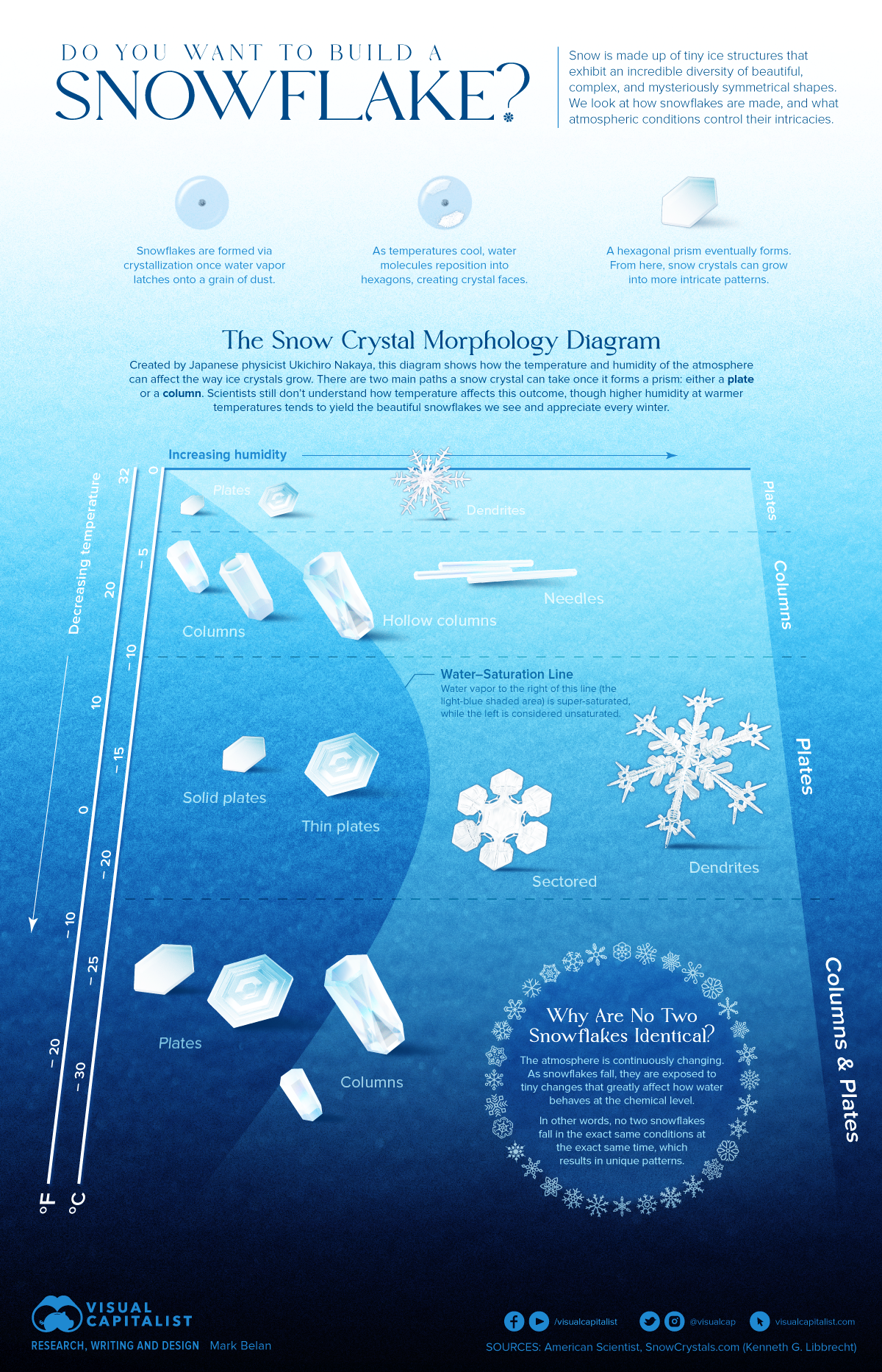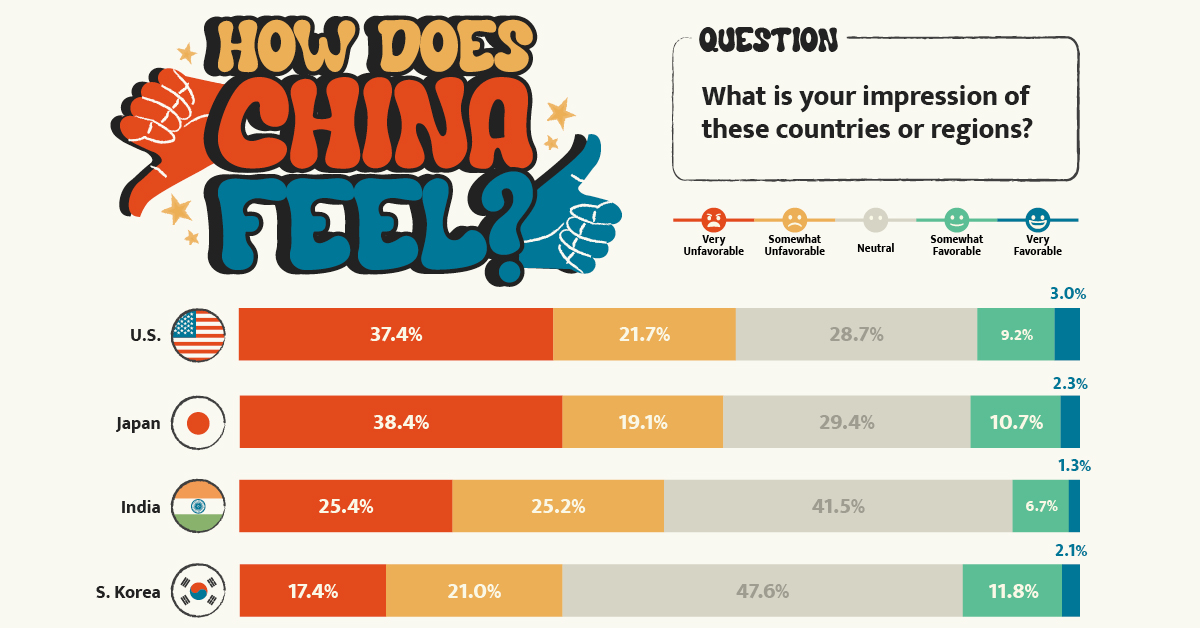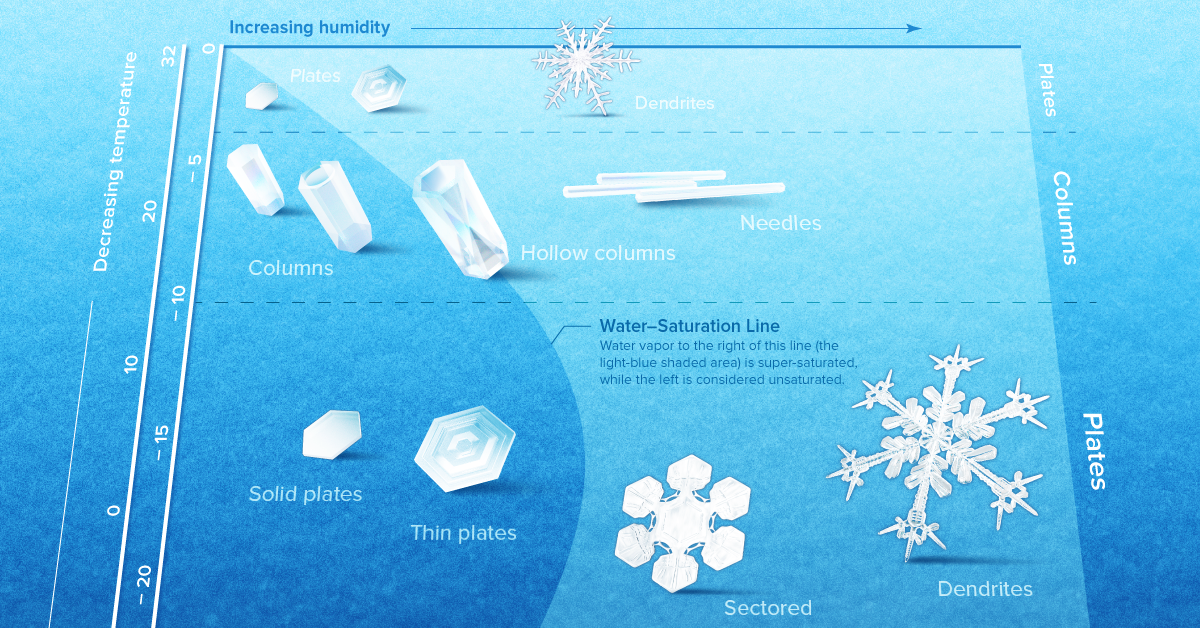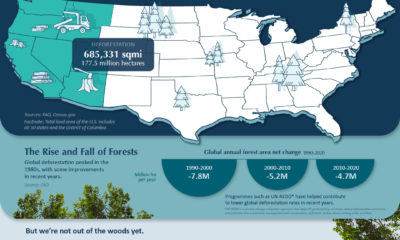Misc
Visualized: How Snowflakes are Formed

The Art of Snow
If you look at snow up close, you will probably notice that it is made up of thousands of tiny flakes with beautifully complex designs.
These snowflakes are actually ice crystals. They form in our atmosphere, high in the clouds, and transform along their journey to Earth thanks to different factors and forces.
We look at how snowflakes are formed, and what atmospheric conditions contribute to the beautiful intricacies we’ve come to know them for.
How to Build a Snowflake
The designs of snowflakes are actually products of a crystallization process that is controlled by the atmosphere.
Water vapor in the atmosphere latches onto a free-floating speck of pollen or dust and acts as a nucleator. This means that it can begin to add on (ie. nucleate) more water molecules and grow in size. When this happens at cold temperatures, water also freezes and crystallizes.
Despite the many unique styles of snowflakes, they all crystallize in the exact same shape—a hexagon. The reason for this has to do with how water behaves at the chemical level. At room temperature, water molecules flow randomly around each other, forming and breaking bonds endlessly.
When temperatures cool, however, they begin to lose kinetic energy and form more stable bonds. By 0°C, they reorient themselves into an energetically-efficient position, which happens to be a rigid, hexagonal configuration. This is frozen water, or ice.
All snowflakes nucleate and crystallize this way. As more water molecules nucleate to the infant snow crystal, they crystallize long arms and branching tendrils, forming unique, artistic designs.
How these designs materialize is simply a matter of water availability and temperature, a relationship best described in the Nakaya Diagram of Snowflakes.
The Nakaya Diagram of Snowflakes
In the 1930s, Japanese physicist Ukichiro Nakaya created the first artificial snowflakes and studied their growth as an analog for natural snow crystal formation. The Snow Crystal Morphology Diagram, or the Nakaya Diagram, is his handy chart that illustrates how snowflakes are formed.
The diagram illustrates the kinds of snowflakes that form via atmospheric temperature and humidity during a snow crystal’s fall to the ground.
Snowflake size and complexity depend on the humidity of the atmosphere. More water means larger, more intricate snowflakes.
Surprisingly, snowflakes cycle between two classes of growth (plates vs. columns) as temperatures decrease.
Close to its 100-year anniversary, this detail of the Nakaya diagram still puzzles researchers today. Many continue to theorize and demonstrate how this phenomenon may be possible.
Start the Same, Finish Different
You might be wondering how it is possible that no two snowflakes are identical if they all have a hexagonal inception and can form only columns or plates.
The answer lies in the dynamic nature of the atmosphere.
The atmosphere is constantly changing. As each second goes by, temperature, humidity, wind direction, and a number of other factors bombard a snow crystal as it falls to the ground.
Snow crystals are sensitive to the tiniest of these changes. Water vapor that is crystallizing responds to different exposures which ultimately make new patterns.
Since no two snowflakes travel in the exact same path at the exact same time, no two snowflakes will look the same. Same start, different endings.
Politics
How Do Chinese Citizens Feel About Other Countries?
What is the Chinese public’s view of world powers? This visual breaks down Chinese sentiment towards other countries.

Public Opinion: How Chinese Citizens Feel About Other Countries
Tensions over Taiwan, the COVID-19 pandemic, trade, and the war in Ukraine have impacted Chinese sentiment towards other countries.
This visualization uses data from the Center for International Security and Strategy (CISS) at Tsinghua University to rank survey responses from the Chinese public on their attitudes towards countries and regions around the world.
Chinese Sentiment Towards Other Countries in 2023
In the Center’s opinion polls, which surveyed a random sample of more than 2,500 Chinese mainland adults in November 2022, Russia came out significantly ahead.
Just under 60% of respondents held Russia in a favorable view, with 19% seeing the country as “very favorable.” Contrast that to the mere 12% that viewed the U.S. in a positive light.
Here’s a closer look at the data. The percentages refer to the share of respondents that voted for said category.
| Country/Region | Very Unfavorable | Somewhat Unfavorable | Neutral | Somewhat Favorable | Very Favorable |
|---|---|---|---|---|---|
| 🇺🇸 United States | 37.4% | 21.7% | 28.7% | 9.2% | 3.0% |
| 🇯🇵 Japan | 38.4% | 19.1% | 29.4% | 10.7% | 2.3% |
| 🇮🇳 India | 25.4% | 25.2% | 41.5% | 6.7% | 1.3% |
| 🇰🇷 South Korea | 17.4% | 21.0% | 47.6% | 11.8% | 2.1% |
| 🇪🇺 European Union | 9.3% | 15.6% | 57.6% | 14.1% | 3.3% |
| Southeast Asia | 7.1% | 13.1% | 59.5% | 16.8% | 3.5% |
| 🇷🇺 Russia | 3.0% | 4.8% | 33.7% | 39.4% | 19.0% |
Japan ranked just below the U.S. in terms of overall unfavorability, though a slightly higher share of respondents saw Japan as “very unfavorable” compared to America. This is likely due to both modern tensions in the East China Sea over mutually claimed islands and historical tensions over the Sino-Japanese Wars.
Chinese sentiment towards India was also unfavorable at just over 50%, though notably the country also received the lowest favorability rating at just 8%.
Additional Survey Findings
The survey also found that 39% of Chinese people get their information on international security from Chinese state-run media (mainly through TV), with an additional 19% getting information from government websites and official social accounts. Conversely, only 1.7% get their news from foreign websites and foreign social media, partially due to the Great Firewall.
When asked about different international security issues, the biggest shares of Chinese citizens ranked the following as their top three:
- Pandemics (12.9%)
- Disputes over territory and territorial waters (12.9%)
- China-U.S. relations (12.0%)
The pandemic’s high score reflects the harsher impact COVID-19 had on China. Chinese borders were shut for years and the public faced intense measures to reduce spread.
In terms of other world events, the majority of Chinese people align with a more “Eastern” viewpoint. For example, in regards to the war in Ukraine, the report found that:
“About 80 percent of the respondents believe the U.S. and Western countries should be held most accountable [for the war], while less than ten percent of the respondents argue that Russia is mainly responsible.”– Center for International Security and Strategy, Tsinghua University
Overall, the views of the Chinese public reflect the opposite of those found in many Western countries. They provide an important insight that it is not just the Chinese government holding particular views about the world, but the Chinese public as well.
-

 Markets4 weeks ago
Markets4 weeks agoThe World’s Biggest Mutual Fund and ETF Providers
-

 Business2 weeks ago
Business2 weeks agoBrand Reputations: Ranking the Best and Worst in 2023
-

 Green5 days ago
Green5 days agoHotter Than Ever: 2023 Sets New Global Temperature Records
-

 Datastream4 weeks ago
Datastream4 weeks agoCan You Calculate Your Daily Carbon Footprint?
-

 Energy2 weeks ago
Energy2 weeks agoWho’s Still Buying Russian Fossil Fuels in 2023?
-

 VC+4 days ago
VC+4 days agoWhat’s New on VC+ in July
-

 Investor Education4 weeks ago
Investor Education4 weeks agoVisualizing BlackRock’s Top Equity Holdings
-

 Technology2 weeks ago
Technology2 weeks agoMeet the Competing Apps Battling for Twitter’s Market Share














